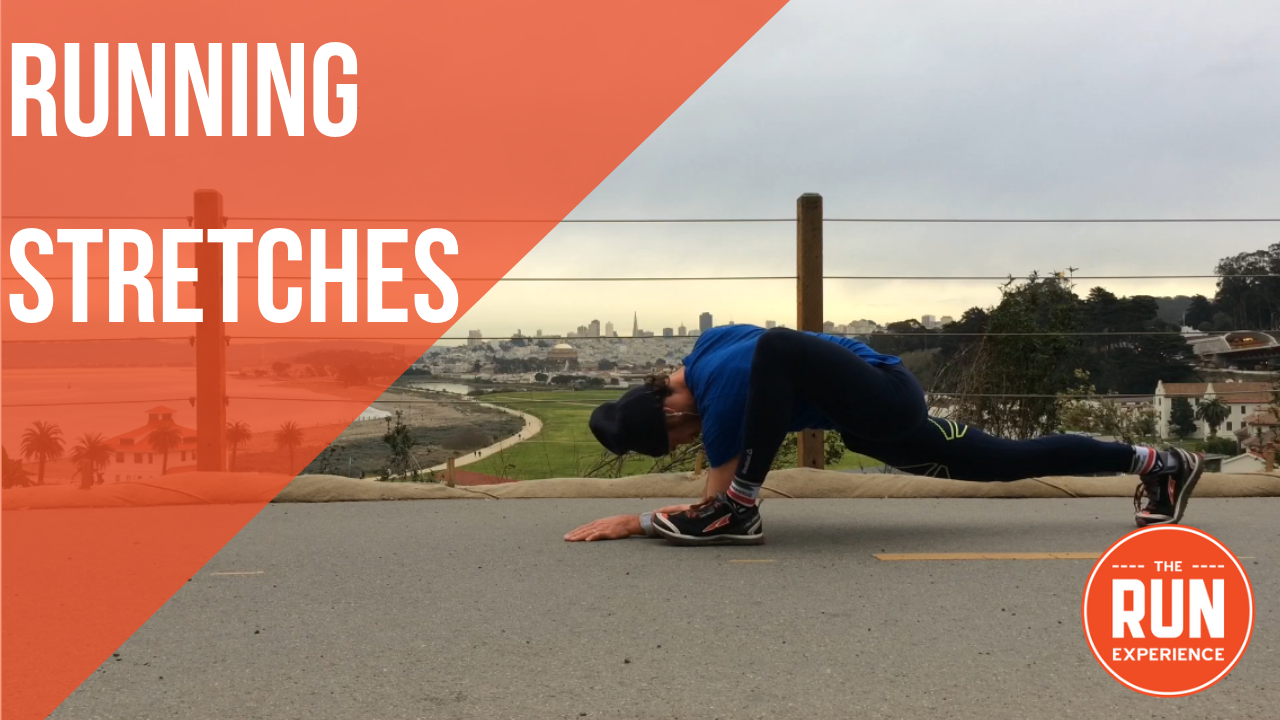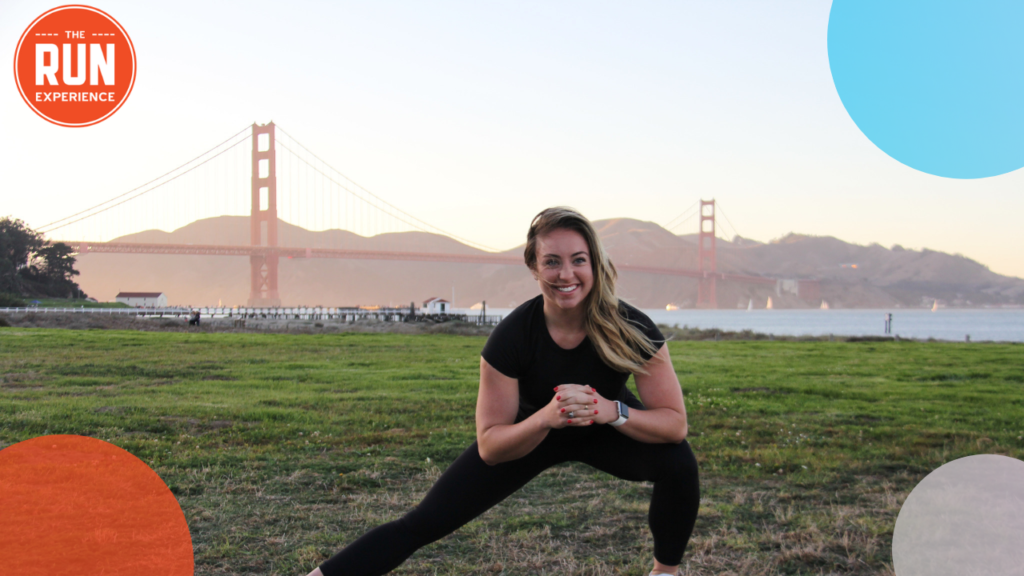5 Pre-Running Stretches for Faster Sprints on the Track
Use these pre-running stretches for running faster sprints, track races, or 5Ks. Add them to your routine for speed and injury prevention.

If you were like me as a college runner, you hated doing pre-running stretches before and after training. I’d do it with the group, but if I was on my own that day, I’d often skip it altogether.
I was busy–and I thought stretching was BORING. I just wanted to hit the road and get into my workout immediately. But, over time, I realized how my lack of pre-running stretches left me with sore, tight muscles and contributed to injuries that could have been prevented.
Pre-workout running stretches don’t have to take a ton of time. Even ten minutes or so can dramatically improve your running form speed and help you feel stronger, run faster, and prevent injuries.
Pro Tip: While pre-run dynamic stretching is crucial–so is deeper, post-run static stretching. Don’t forget to practice stretching at the end of your run. Stretching after a workout is just as important as beforehand to prevent stiffness and keep your muscles and joints healthy.
Let’s follow along with Nate to learn about running stretches that help us open our joints and prime our muscles for an excellent, enjoyable run that pushes us one step closer to our goals.
Should Sprinters Do Stretches Before Running?
Whether to stretch before running has been the subject of extensive debate and research. To provide a clear answer, it's essential to distinguish between two primary stretching types: static and dynamic.
Static Stretching
Static stretching is when you hold a stretch in a stationary position for a duration (usually 15-60 seconds). It focuses on lengthening individual muscles to the point of mild discomfort and then maintaining that position.
Pros
- Can help improve flexibility when done consistently over time.
- Can be beneficial post-run to alleviate muscle tightness.
Cons
- Research has shown that static stretching before a workout can temporarily weaken the stretched muscles, potentially decreasing strength and performance.
- There's a risk of overstretching, leading to muscle strains if done too aggressively.
- Some studies suggest that static stretching before a run does not necessarily reduce the risk of injury.
Dynamic Stretching
Dynamic stretching involves moving parts of your body and gradually increasing reach, speed, or both. It is active, uses range-of-motion movements, and is more sports-specific.
Pros
- Increases blood flow and raises body temperature, preparing muscles and joints for activity.
- Enhances the range of motion and muscle function.
- Can mimic the actions of running, making it a sport-specific warm-up.
- Studies suggest it can improve performance and reduce injury risk compared to no stretching at all.
Cons
- If done incorrectly or too aggressively, there's a risk of injury.
- Might not provide the same extent of muscle relaxation and lengthening as static stretching (though this isn't necessarily the primary goal before running).
Recommendation for Runners: To Stretch or Not to Stretch
Before Running: Focus on a warm-up that includes dynamic stretching. Examples include leg swings, arm circles, walking lunges, butt kicks, high knees, and torso twists. This warm-up will increase your heart rate, get blood flowing to the muscles, and prepare your body for running.
After Running: Post-run is a good time for static stretching when the muscles are warmed up. This style of warming up can help in muscle relaxation, potentially aiding in recovery and maintaining flexibility.
If you prefer to incorporate static stretches before your run, ensure it's done after a brief warm-up when the muscles are not cold. Also, do not push the stretch to the point of pain—aim for mild tension.
While static stretching before a run might not harm recreational runners when done correctly, current best practices lean towards dynamic stretching as part of a warm-up routine. Always listen to your body, consider what feels right, and adjust your stretching regimen when/if needed.
Best Stretches for Sprinters: Pre-Running Stretches for Running Faster
1. The Run-High Knee-Run-Butt Kick Stretch
This initial exercise starts to get your heart rate up and helps open your joints.
- Run for 20 seconds in place with a tall posture and relaxed arms, lightly pulling your feet off the ground with each step.
- As you keep running in place, bring those knees up with each step for 20 seconds–about 50% as high as an all-out high knee effort–we’re just getting started!
- Switch to 20 seconds of butt kicks–again, we are going for about 50% effort to warm up your hamstrings.
- Start the cycle over. This time, bring the high knees and butt kicks up to 75-100%.
2. Lateral Lunges
This stretch is awesome for opening the hips and getting the blood flowing in your legs.
- Assume a wide, square stance–yep, imagine a starting wrestling pose!
- Place your hands on your hips, or support them on your thigh if you need a little support. For a more advanced move, place your hands behind your head.
- Lunge from side to side, keeping your hips back and head and chest tall.
- Complete 20 lunges.

3. The Hip Circle Stretch
We’ll roll right into this stretch from the lateral lunge to continue to loosen and strengthen the hips, legs, and your groin and glutes.
- At the end of the last lunge, place your hands on the ground and rotate into a traditional long lunge position.
- Your forward foot should be on the outside of your shoulder, with your toes straight.
- With your front foot flat and your back foot with a raised toe, rotate your hips ten times in a circle clockwise and ten times counterclockwise.
- Walk your hands over and lean into a low lunge on the other side. Repeat ten circles.
4. Elbow Touches
Once you’ve completed the hip circles, stay low in the lunge position and walk your hands back to the other side. It’s time for elbow touches to finish warming up the hips.
- Once you’ve walked over, take the elbow closest to your bent leg and lightly touch it to the ground.
- Walk your hands to a low lunge on the opposite side. Touch the other elbow down.
- Keep your hips low and center for 20 elbow touches.
5. Arm Circles
Your legs and hips should be warm and ready to run. You’ll finish up with some arm circles to get your arms on board and promote a relaxed, arm swing with your stride.
- Rather than traditional arm swings, this exercise involves simultaneously moving one arm forward and one backward.
- Start with both arms over your head, and place one arm in front of your face and one behind your head.
- Start moving each arm in full circles in opposite directions. After ten circles, stop and switch directions. Repeat ten circles.
- If this simply feels too funky and you can’t get the opposite swing down, that’s okay! Try a couple of times, and if it isn't happening, do traditional arm swings in the same direction–and try out the variation again next time.
Tips for Better Track Stretches
Maximize your pre-run stretching routine with these practical tips:
- Stay Consistent: Make stretching a regular part of your pre-run routine. Consistency is key to reaping the benefits of improved flexibility and injury prevention.
- Warm Up First: Always start with a light jog or brisk walk to get your blood flowing before diving into dynamic stretches. This helps prepare your muscles for the more intense movements to follow.
- Focus on Form: Ensure that you’re performing each stretch correctly to avoid injury and get the most benefit. Keep your movements controlled and deliberate.
- Listen to Your Body: Pay attention to how your body feels during each stretch. If something feels uncomfortable or painful, modify the stretch or consult a coach or physical therapist.
- Breathe Deeply: Don’t forget to breathe. Deep, steady breaths can help you relax and deepen each stretch, improving its effectiveness.
- Use a Timer: To ensure you’re giving each stretch adequate attention, use a timer to keep track of your stretching intervals. Aim for about 20-30 seconds per stretch.
- Gradually Increase Intensity: As you become more comfortable with your stretching routine, gradually increase the intensity and duration of each stretch. This will help you continue to make progress without overexerting yourself.
- Hydrate: Drink water before, during, and after your stretching routine. Hydrated muscles are more pliable and less prone to injury.
- Cool Down Properly: After your run, include static stretches to help relax and lengthen the muscles you’ve worked. This can aid in recovery and reduce muscle soreness.
Incorporate These Into Your Pre-Run Stretching Routine
That’s it! It shouldn’t take you more than ten minutes to complete these dynamic running stretches that set you up for a great run.
Interested in learning about more running stretches? Check out our YouTube playlist full of strength training workouts! Also, be sure to check out our list of training programs for runners of every level today!
